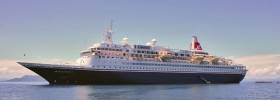Displaying items by tag: First cruiseship of 2017
#CruiseFirst - A pair of Fred Olsen Lines sisters marked both the last cruise call to Dublin Port in 2016 and as the first of the New Year, writes Jehan Ashmore.
The conservative yet handsome profile of Boudicca sailed into Dublin at dawn. The 880 passenger cruiseship had sailed from the opposite side of the Irish Sea having cast off mooring ropes from Liverpool’s famous waterfront. The ship had berthed at the cruise terminal located near the landmark buildings known as the ‘Three Graces’.
On boards are cruise-goers taking in the early New Year sights and visiting tourist attractions of Dublin's 'Fair City' before Boudicca sets sail this evening at 18.00hrs. The next port of call been Southampton. Likewise of the Irish capital, the Hampshire port is the UK’s busiest for cruiseships along with trading in general cargo, notably through giant ocean-going containerships.
Within the last fortnight sister, Black Watch had too disembarked tourists to visit Dublin which in 2016 the port welcomed 112 cruiseships.
The veteran vessels of 28,000 gross tonnage each and dating to the 1970’s belong to an increasing rare breed of first generation cruiseships. With the passing of more than four decades they have become by default yet even more pleasing to the aesthestic eye.
In comparison to some of the behemoths of modern day cruiseships and newbuilds that will descend into the Dublin Port of the future using a new cruise €30m terminal granted planning permission.
The facility a first for the port is part of the Alexandra Basin Redevelopment (ABR) Project. This is phase one of the Masterplan for the port up to 2040.
Currently the vast majority of cruiseships dock in Alexandra Basin (west and east). It is in the east basin, the larger of the two where Boudicca of 206m in length is berthed alongside Ocean Pier. This is also where larger cruiseships of 300m in length dock while considerably smaller ships can head downriver close to the city quays.
Port access issues such as restrictions on overall cruiseship dimensions will be resolved by an extensive dredging programme within the port but also the approach channels off Poolbeg Lighthouse.
This will enable the largest cruiseships in the world to dock following realignment of quays within Alexandra Basin. Such works will permit these massive cruiseships up to 340m in length to swing around the increased turning circle inside the basin.





























































